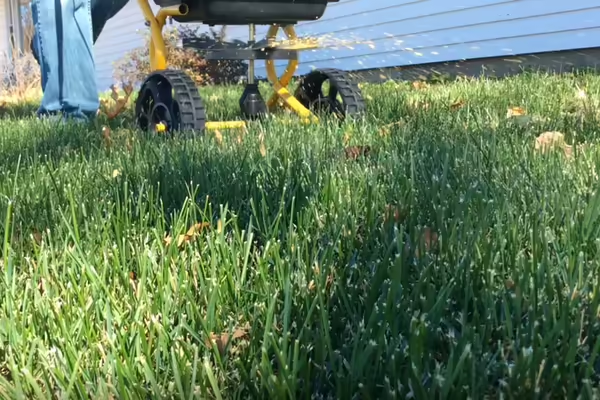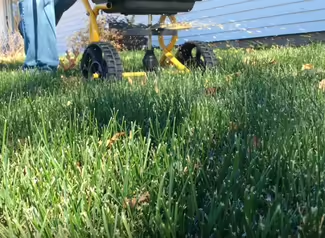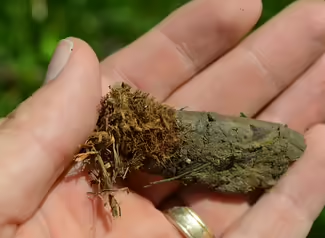
URBANA, Ill. — As the sun sets on another summer season, lawn care does not stop. When it comes to routine turf maintenance, the late summer to early fall months are critical for cool-season lawns.
Cool season lawns are a group of turf species comprised mainly of Kentucky bluegrass, tall fescue, perennial ryegrass, and fine fescue. Many Illinois homeowners with a lawn are likely to have a cool-season type. Cool-season lawns green up quickly in the spring and fall but may go dormant during the hottest part of summer.
Cool-season lawns coming out of a hot, dry summer will be stressed and could use some tender, loving care. The following are five tips to give a lawn a pick-me-up as the summer fades to fall.
- Aerate. Aeration is a great way to relieve soil compaction and reduce thatch. The machine for the job is a hollow-tine aerator or core aerator. Operate the core aerator a few days after rain when the soil is still slightly damp. Core aerators cannot cut into hard, dry soil. Leave the soil cores to break down over the next few weeks.
- Overseed. Broadcast seed into an established lawn with a seeder or by hand. Slit seeders are a great tool for overseeding into established lawns. Select a high-quality seed and set the seeder at the correct rate.
Bonus Tip: To patch bare spots, rake up the soil surface for good seed-to-soil contact. Mix bagged topsoil with bagged compost 50/50. Combine grass seed with the soil and compost mix at a 3:1 ratio. Three scoops of soil mixed with one scoop of seed. Apply the 3:1 mix to the bare spot, and firm up the patch by hand. Keep the area moist until germination and follow up with watering while the young grass plants develop.
- Fertilize. Apply one pound of nitrogen fertilizer per 1,000 square feet. If a lawn only gets one feeding a year, it should be before fall. The window for Central Illinois is August 15 through September 15. Adjust accordingly to early August in northern counties, and September for southern counties.
Optional: Apply a late-season fertilizer called a winterizer one week after the final mowing of the season.
- Mulch clippings and leaves. By bagging clippings and leaves, nutrients are taken away from the soil. Ditch the bag and return those nutrients and organic matter back to the lawn. Lawns, where clippings are not bagged, can go longer between fertilizer applications. Research at Michigan State University shows that shredding fall leaves into the turf can improve lawn health. For those wishing to preserve leaves for insect overwintering habitat, rake the leaves from the desired lawn space into planting beds.
- Perennial weed control. Fall is also a great time to kill broadleaf weeds such as dandelion or creeping Charlie. At this time of year, perennial weeds prepare for winter, sending carbohydrates to their roots. Applying a systemic herbicide at this time will be more successful at killing the entire plant, above- and below-ground. Once the weeds are dead, cool temperatures are conducive for cool-season turf to fill in the bare spots.
For more on lawns, visit extension.illinois.edu/lawns. For questions, connect with a location Extension office at go.illinois.edu/ExtensionOffice.
Chris Enroth is an Illinois Extension horticulture educator for Henderson, Knox, McDonough, and Warren counties. Gardeners Corner is a quarterly newsletter from gardening experts around the state. Each issue highlights best practices that will make your houseplants, landscape, or garden shine in any season. Join the Gardener’s Corner email list at go.illinois.edu/GCsubscribe for direct access to timely tips.
PHOTO CAPTION: Adding fertilizer is only one way to show a lawn some care after a long, hot summer season fades to fall. Photo: Chris Enroth, Illinois Extension.
University of Illinois Extension develops educational programs, extends knowledge, and builds partnerships to support people, communities, and their environments as part of the state's land-grant institution. Extension serves as the leading public outreach effort for University of Illinois Urbana-Champaign and the College of Agricultural, Consumer and Environmental Sciences in all 102 Illinois counties through a network of 27 multi-county units and over 700 staff statewide. Extension’s mission is responsive to eight strategic priorities — community, economy, environment, food and agriculture, health, partnerships, technology and discovery, and workforce excellence — that are served through six program areas — 4-H youth development, agriculture and agribusiness, community and economic development, family and consumer science, integrated health disparities, and natural resources, environment, and energy.


